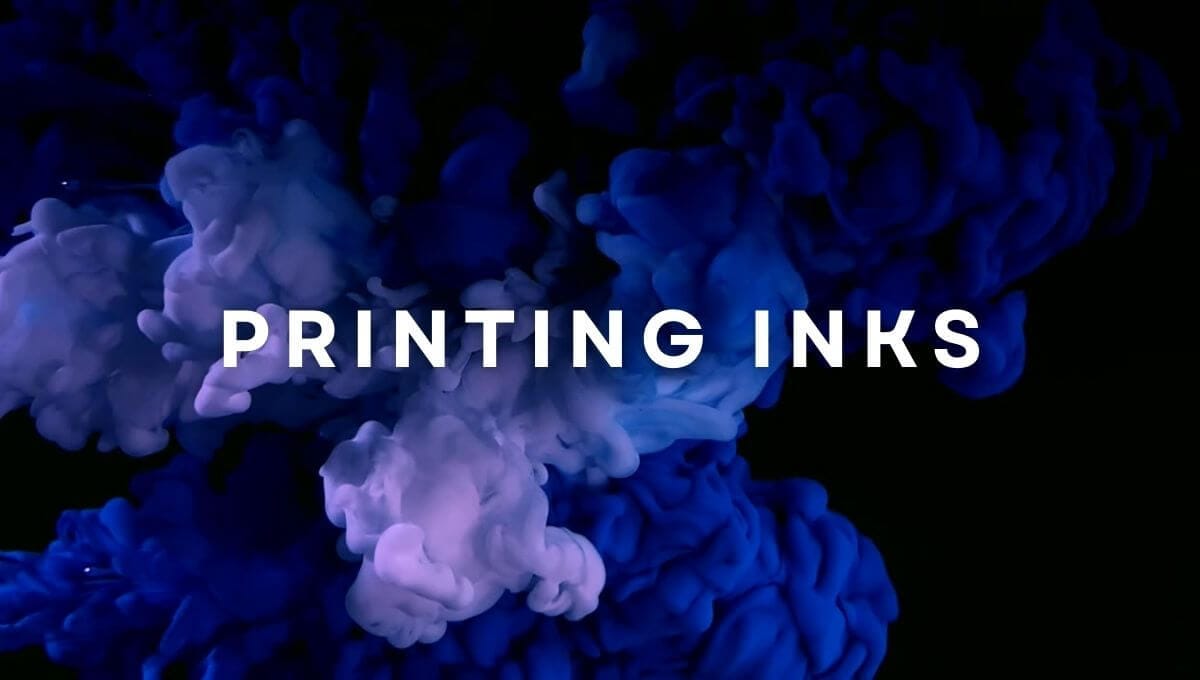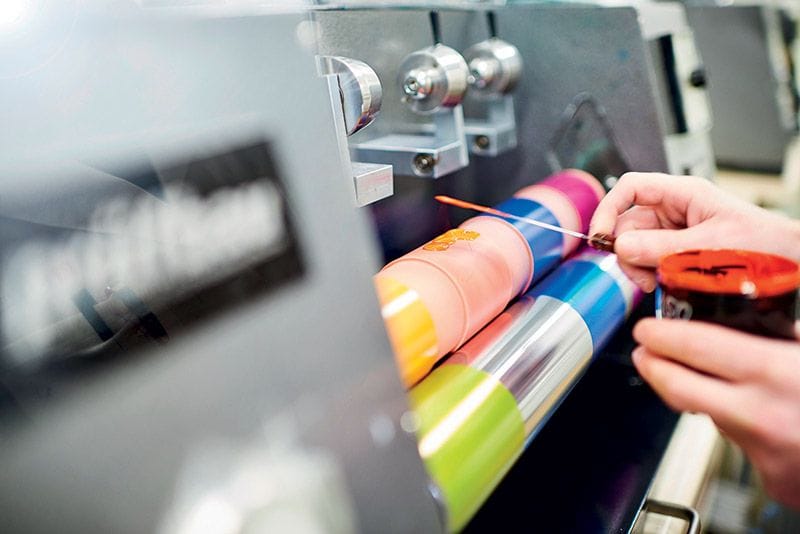Printing Inks: Everything You Need To Know

Printing inks are becoming important in a variety of industries. They serve as the colorful lifeblood that brings words, images, and designs to life on paper, packaging, textiles, and more.
Various industries are already implementing this essential tool. Printing inks allows for more efficient and high-quality label production. The market is growing rapidly and is expected to exceed up to 25 billion by 2029.
Whether you're a small business or an industry expert, knowing the printing and how to use it effectively is essential.
That's why we created this guide. In it, you'll learn about printing inks, their types, and much more. It'll help you choose a suitable printing ink for your business needs.

Source: packagingmag
Brief History Of Ink
The ink was created so humans could record all their thoughts and ideas. In ancient times, it was used on cave walls, but now it's commonly used to write on paper. So, we can say that ink has come a long way.
Indians were known for using ink in the 4th century BC. It was made from three major materials.
- Burnt bones
- Pitch
- Tar
Evidence suggests that ink was also used by ancient Chinese civilizations in 256 BC. These Chinese inks were quite different from Indian inks as they were made from fish glue.
Today, carbon black is still used to make black inks. But the process is not as simple as it used to be; it's becoming more complex.
What Are Printing Inks?
Printing inks are specialized liquids or pastes containing pigments, binders, solvents, and additives. They are used in various printing processes to transfer text, images, or designs onto surfaces like paper, cardboard, fabric, or packaging materials.
The complex mixture of chemical compounds can stain any surface. The compound can be in any form, either solid, liquid, or gas. It can later transform from its base form to different states because of physical, chemical, or drying methods.
Printing inks are most often in liquid or paste forms. But how can you tell which form it is?
It depends on three major factors. These are:
- Color
- Gloss
- Transparency
Manufacturers use different methods to develop ink with specific qualities. Some examples are high-gloss, metallic, and magnetic inks.
Components of Printing Inks
Printing ink is made carefully with the aid of these components. The careful combination and balance of these components are extremely important because they contribute to the functionality and quality of the printing ink. So, it is crucial to ensure that these components meet the requirements of different printing processes and produce high-quality results.
- Pigments: Finely ground colorants that give the ink its color.
- Binders: Substances that hold pigments together and promote adhesion to the printing surface.
- Solvents: Control the viscosity of the ink and aid in drying, allowing it to set on the printing surface.
- Additives: Additional substances that enhance specific properties of the ink, such as drying agents, stabilizers, and defoamers.
- Resins: As part of the binder system, different types of resins contribute to the overall durability and adhesion of the ink.
Common Types of Printer Inks
Because of modern technology, printing inks has evolved a lot. It has given rise to a wide variety of sustainable printing inks that are also high-quality and cost-effective. Here are some of them.
Pigment ink
This ink consists of dry and encapsulated particles. They are suspended in the ink. Afterwards, it dries quickly and has a long print life. Not only this, it has better resistance to:
- Scratches
- Water
- Uv rays
It's ideal for product packaging because of its color and consistency. However, achieving the same color and consistency all the time can be extremely difficult. So, customers may notice inconsistency in the color. Based on the light, the color varies a bit.
They are widely used because of their longevity, but their pigment inks are expensive. This might not be your best choice if you have a detailed print work.
It's best for slicker surfaces, which include stickers and transparencies. Do you know why?
Because instead of absorbing the surface, it adheres to the surface strongly.
Dye-based ink
These are amazing mediums that increase not only brightness but also vibrancy. They also offer density, making them suitable ink for high-quality printing jobs.
It's made with colorations heavily dissolved in a liquid- either water or glycol. Because of this, you'll notice that dye flows smoothly from the printer to the page.
These inks come in a wide range of colors and shades worldwide. They're best for commercial purposes.
Because you can get high-quality prints without breaking the bank, but there's just one problem.
It can fade away quickly. The major reason for that is the paper absorbs that ink. Hence, it's likely to break down, fade, and change color if the printer exposes the paper to water or sunlight.
Solid ink
It's also known as hot melt ink. It's a waxy resin-based polymer that manufacturers basically melt into a liquid using heated printheads.
No fluid ink or toner is used.
Instead, solid ink in the form of sticks, crayons, or grains is used. The result is a glossy, high-quality, and almost opaque print.
However, manufacturers should regularly maintain the ink and filter any impurities or contaminants. Why is that important?
Because that reduces the chances of ink clogging print heads.
Sublimation ink
It is made of dye particles that are ground into powder. Later, they are suspended in a liquid carrier, which can be either water or solvent.
It differs from traditional inks because it prints the reverse image on the transfer paper. It's before the placement of print on the medium.
After the image is heated, the printing process causes the dye to heat up and convert into a gas. One color is printed at a time, which produces vibrant and distinct prints.
Many manufacturers use this to print high-quality images and texts on clothing. The initial polyester coating, which leads to better adherence, is recommended for use on other surfaces such as metal, wood, or ceramic.
Ribbon ink
It is used with dot matrix and thermal printers. Its purpose is to transfer dried ink onto a product's packaging.
The ink-soaked ribbon is pressed heavily when you use it with dot matrix or impact printers.
Why?
It's pressed against the page to get a high-quality print. However, heat is used in thermal transfer prints to melt the wax into a resin coating, exposing the ink for printing purposes.
Inkjet Vs. Laser Printer Inks
There are two major types of printers, and there's often a debate about which suits your business.
So here's a quick table of differentiation to help you understand the difference between these terms.
|
Aspect |
Inkjet Printer Inks |
Laser Printer Inks |
|
Printing Technology |
It uses liquid ink ejected through tiny nozzles |
Employs toner, a powder-based ink fused onto paper |
|
Speed |
Slower compared to laser printers |
Generally faster, especially for text documents |
|
Quality |
Excellent for high-resolution photo printing |
Sharp and precise, particularly for text and graphs |
|
Cost |
Initial printer costs can be lower |
Toner cartridges can be more cost-effective in volume printing |
|
Color Accuracy |
Typically, better color accuracy and vibrancy |
Accurate for text and graphics, but photo quality may vary |
Printing Inks Market Trends
Knowing market trends is extremely crucial because that way, you can quickly adapt. So here are some trends that you should know.
The use of non-toxic materials in printing ink is highly supported, even though strict regulatory policies and bodies ensure that the excessive use of toxic materials is reduced. Now, non-toxic materials such as graphene and modified celluloid, which are also economical, are made.
Many experts suggest that there will be a huge demand for 3D printing in the upcoming years because 3D printing keeps the audience hooked and engaged.
Attention is the new currency, and with 3D printing, capturing attention is easy.
Benefits of Using Printing Inks
Now that you know about printing inks and their types, let's discuss some of their benefits to understand how this is extremely beneficial for your business.
- Customization: Inks can be formulated to meet specific printing requirements. Thus allowing for customization based on factors like drying time, adhesion, and substrate compatibility.
- Specialized Applications: Printing inks are tailored for various applications, from standard printing needs to specialized uses like packaging, textiles, and electronic components.
- Color Variety: The inks allow for a vast array of colors, enabling vibrant and visually appealing printed materials.
- Precision and Detail: Printing inks can achieve high levels of detail. Thus making them suitable for producing intricate designs, fine text, and high-resolution images.
- Versatility: They are adaptable to various printing surfaces, including paper, cardboard, fabric, and more, making them versatile for different industries and applications.
Ending Thoughts
Ink usage has transformed in many ways worldwide. The printing ink industry initially faced slow growth, but now it's blooming and becoming a top choice for many businesses.
The changes are continuing, which is leading to innovation and environment-friendly efforts. Moreover, manufacturers are making efforts to provide sustainable printing solutions.
In a nutshell, printing ink forms the vibrant link between ideas and reality in diverse industries. But to achieve uniqueness, you must understand printing ink types, components, and other benefits. It will give you a quick glimpse of what you can expect from using it.
Remember to stay ahead of your competitors by staying knowledgeable about the latest trends and updates in the industry. It will give you a competitive edge.
